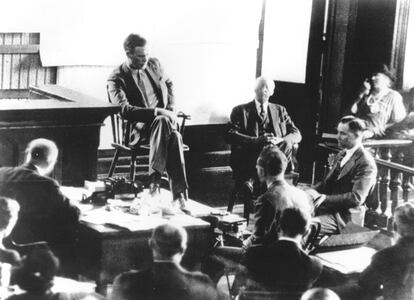True crime fever fuels macabre theory on the tragic death of Charles Lindbergh’s baby
Lise Pearlman, a retired judge and thriller writer, claims the first pilot to fly solo across the Atlantic was primarily responsible for the death of his 20-month-old son in 1932


The abduction and murder of pilot Charles Lindbergh’s baby boy back in 1932 shocked the world. Charles Lindbergh became a hero in American lore when he flew single-handedly non-stop across the Atlantic in 1927, earning himself the moniker, “Lucky Lindy.” So when his 20-month-old toddler disappeared on March 1, 1932, apparently stolen from his crib at the family home in Hopewell, New Jersey, few were prepared to believe he might be involved.
Now, 92 years after the event, a macabre new theory has surfaced and is being taken seriously by heavyweights in the U.S. judicial system. After undertaking extensive research, Lise Pearlman, a retired California judge turned best-selling crime novelist, has reached the conclusion that the German immigrant Bruno Hauptmann, a New York carpenter who went to the electric chair for the baby’s murder in 1936, is innocent.
“The wrong man was executed,” Pearlman told the San Francisco Chronicle in January. “My hope is that Hauptmann will be posthumously exonerated. And I am certainly not the only one who wants that.” Pearlman, who lives in Oakland, published her book Suspect No.1 in 2020. It analyzes alleged failures by the prosecution during the trial and contextualizes the 1932 coroner’s report. The 550-page text includes a new analysis by a renowned pathologist involved in other high-profile cases in the U.S. justice system.
In the wake of the San Francisco Chronicle interview, the book has become something of a sensation in the very active true-crime-fan community. Genre authors and judicial experts have praised Pearlman’s investigation as “well-researched,” “powerfully argued,” and “very plausible.” Lowell Jensen, a retired federal judge who worked in the U.S. Attorney’s Office, considers it a “definitive” book on the Lindbergh saga.

Charles Lindbergh’s aviation feat may always be considered an important landmark in American history, but Lindbergh had a dark side that has also been extensively documented. Philip Roth’s The Plot Against America imagined an alternative America where the ideas of Lindbergh, a Nazi Germany sympathizer and white supremacist, were adopted by the majority. The Rise and Fall of Charles Lindbergh, a 2020 biography by Candace Fleming aimed at younger readers, recalls that the hero led incendiary rallies in which he called journalists “dishonest parasites” and demanded the closing of America’s borders to prevent “alien blood” from coming into the country.
Pearlman believes Lindbergh was responsible for the death of his son, Charles Augustus. According to Pearlman, Lindbergh may have lent his baby boy to the French scientist Alexis Carrel to carry out scientific experiments on his organs. The former judge points out that Carrel’s team extracted, “at the very least,” his carotid “and probably his thyroid.” These were “kept viable” for transplantation for 30 days. “We believe he died on the operating room table,” Pearlman told the San Francisco newspaper.
Pearlman imagines that Lindbergh fabricated the tale of his son’s abduction to avoid investigation. Both Carrel, a 1912 Nobel Prize winner, and Lindbergh believed in eugenics, the philosophy of race improvement through genetic manipulation embraced by Nazism. “I believe Lindbergh was present during the operation,” Pearlman told the San Francisco Chronicle.
Pearlman’s research consisted of trawling through essays written by the French biologist and examining dozens of photographs of the baby, who had a larger-than-normal head and was a sickly child. His body was found in a decomposed state in an open field near the family’s home on May 12, 1932, more than two months after he disappeared. The remains were cremated without an autopsy.
According to Pearlman, Lindbergh now emerges as the number one suspect, yet he managed to escape justice until his death in 1974. The police captured Bruno Hauptmann two years after the crime when he used a dollar bill that had been part of the ransom at a gas station. In his defense, the man claimed that he had been given the money, some $13,500, from a friend who had returned to Germany. A handwriting analysis conducted by the FBI determined that the handwriting on the supposed kidnapper’s note left in the child’s bedroom demanding $50,000 and Hauptmann’s handwriting were not the same.

Hauptmann’s trial was dubbed “trial of the century.” But Pearlman argues in her book that the case put together by the prosecution was deeply flawed. The authorities did not pursue many of the lines of investigation opened by the police, the prosecution did not allow the defense to study an extensive 90,000-page report, and, according to Pearlman herself, a dozen witnesses presented by the prosecutors lied from the stand, ensuring the German immigrant was sent down for the crime.
Suspect No.1 is not only considered a sensation among true-crime fans, its author has also presented her research to criminology professionals and was invited to the American Academy of Forensic Sciences annual meeting last year to present her findings. She told the experts that key forensic evidence was hidden and other physical evidence altered by New Jersey police to make Hauptmann fit the profile of America’s most wanted man.
Pearlman’s book has even prompted a lawyer to file a lawsuit demanding that New Jersey allow independent experts to analyze the archived evidence from the case. A judge last year turned down the demand, but the decision has since been appealed. Pearlman’s arguments have been sufficiently compelling that the Innocence Project, a nonprofit venture that reviews court cases, is on board to clear Hauptmann’s memory. Other experts in the case, however, take a more skeptical view of Pearlman’s work, maintaining it is close to impossible to prove her theory nearly a century after the tragedy.
Newspapers from the 1930s described the scene of the crime, committed while Colonel Lindbergh, his wife and nanny were at home. A trail of muddy footprints led from the crib to an open window, according to The New York Times archive. When the nanny alerted the parents that the baby was missing, Lindbergh called the police chief directly. Officers determined that the abductor was barefoot or wearing socks, as there were no shoe marks on the floor. The footprints led to a wooded area, where a second, smaller pair of footprints appeared, leading investigators to believe that a woman was involved. In the woods, the search party found a wooden ladder, thought to have been used to reach the baby’s room. Lindbergh refused to speak to the reporters who were present.
The murder of the Lindbergh child had led to dozens of theories and claims over the years, some of them far-fetched. In the 1980s, for example, two men separately claimed to be the grown boy, inferring no murder had been committed. Over the years, evidence collected by the FBI and New Jersey police would be revised. A 1993 book called Crime of the Century: The Lindbergh Kidnapping Hoax has already claimed that the alleged abduction was in fact a ruse and that the child’s father was involved in the baby’s death. Pearlman is just the latest to put a twist in the tale and perhaps contribute to the original verdict being overturned.
Sign up for our weekly newsletter to get more English-language news coverage from EL PAÍS USA Edition
Tu suscripción se está usando en otro dispositivo
¿Quieres añadir otro usuario a tu suscripción?
Si continúas leyendo en este dispositivo, no se podrá leer en el otro.
FlechaTu suscripción se está usando en otro dispositivo y solo puedes acceder a EL PAÍS desde un dispositivo a la vez.
Si quieres compartir tu cuenta, cambia tu suscripción a la modalidad Premium, así podrás añadir otro usuario. Cada uno accederá con su propia cuenta de email, lo que os permitirá personalizar vuestra experiencia en EL PAÍS.
¿Tienes una suscripción de empresa? Accede aquí para contratar más cuentas.
En el caso de no saber quién está usando tu cuenta, te recomendamos cambiar tu contraseña aquí.
Si decides continuar compartiendo tu cuenta, este mensaje se mostrará en tu dispositivo y en el de la otra persona que está usando tu cuenta de forma indefinida, afectando a tu experiencia de lectura. Puedes consultar aquí los términos y condiciones de la suscripción digital.
More information
Archived In
Últimas noticias
Welcome to the post-religion era: The idea of Christianity as the absolute truth has become obsolete
‘I thought you would like it’: The risky sexual practice popularized by TV shows and TikTok
The digitalization of tourism: ‘They promise experiences and gave us the worst possible one’
Mexican peso defies uncertainty with forecasts of a new period of stability in 2026
Most viewed
- Sinaloa Cartel war is taking its toll on Los Chapitos
- Reinhard Genzel, Nobel laureate in physics: ‘One-minute videos will never give you the truth’
- Oona Chaplin: ‘I told James Cameron that I was living in a treehouse and starting a permaculture project with a friend’
- Why the price of coffee has skyrocketed: from Brazilian plantations to specialty coffee houses
- Silver prices are going crazy: This is what’s fueling the rally










































